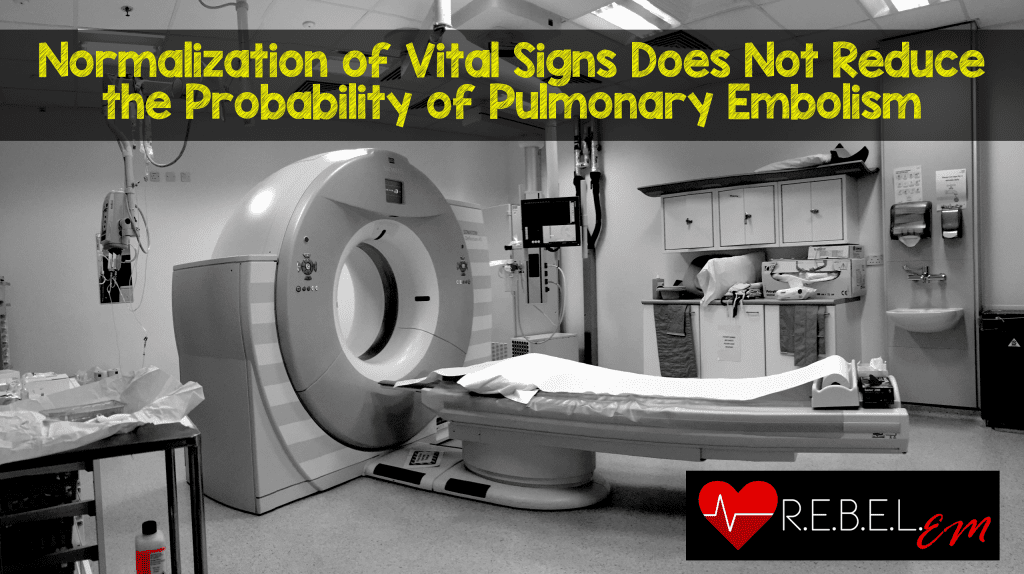 Background: In patients with symptoms of pulmonary embolism (PE), we often turn to vital signs, including heart rate, respiratory rate and pulse oximetry, as part of our initial impression of the patient. Before even considering further testing, such as d-dimer or CTPA, we look first at the vital signs to form our gestalt impression of the patient. Clinical decision making tools are utilized in one static point in time, but gestalt decision-making occurs over the course of the patient’s entire stay in the Emergency Department (ED). Because of this, clinicians may use changes in vital signs to augment their differential diagnosis or to justify their belief that a PE work up is not necessary.
Background: In patients with symptoms of pulmonary embolism (PE), we often turn to vital signs, including heart rate, respiratory rate and pulse oximetry, as part of our initial impression of the patient. Before even considering further testing, such as d-dimer or CTPA, we look first at the vital signs to form our gestalt impression of the patient. Clinical decision making tools are utilized in one static point in time, but gestalt decision-making occurs over the course of the patient’s entire stay in the Emergency Department (ED). Because of this, clinicians may use changes in vital signs to augment their differential diagnosis or to justify their belief that a PE work up is not necessary.
Clinical Question:
Does the normalization of initially abnormal vital signs change to probability of pulmonary embolism in symptomatic patients being evaluated for pulmonary embolism in the emergency department?
Population:
Patient age 17 years or older with at least one of eight predefined signs of PE OR at least one of seven predefined symptoms of PE AND at least one of twenty-one predefined risk factors for PE. Signs, symptoms and risk factors were not explicitly spelled out in this article but were previously written about and referenced. (Courtney 2010)
Outcomes:
The presence of PE in patients suspected of having a PE whose vital signs normalize during their ED course.
Design:
This is a prospective, single-center study. For each patient, the first four sets of vitals signs were recorded and each patient received a CTPA.
Excluded:
- Unlikely to provide follow up (i.e. including prisoners, homeless patients, patients without a telephone and patients with a history of noncompliance)
- Pregnancy
- Hemodynamically Instability
- Intubated
- Unable to breathe through their mouth
- Had fibrinolytic treatment within 48 hours
- Had a PE diagnosed within the previous six months
- On anticoagulation or had known active tuberculosis
Primary Results
- 192 patients enrolled
- 35 study patients with CTPA diagnosis of PE
- 100% 90 day follow up
- On 90 day follow up no patient with a negative CTPA had a new PE (although one had a newly diagnosed DVT)
Critical Results:
- No clinically important difference between the mean vital sign values measured at any point in time for patients who were PE positive vs PE negative.
- Prevalence of PE in patients who had an abnormal triage vital sign that normalized
- Heart rate – 18%
- Respiratory rate – 14%
- SpO2 – 19%
- Shock Index – 33%
Strengths:
- Prospective study
- Investigates and important clinical question without prior research
Limitations:
- Small sample size and single institution
- Patients had to have one of the signs/symptoms AND one risk factor so lower risk patients may not have been included
- Not all patients with a PE diagnosed at the institution during the study period were included in the study.
- Pulse oximetry measurements may have been inconsistently taken on room air or supplemental oxygen
- Serial vital sign measurements were not complete in all patients
- The study did not record the administration of medications or treatments that may have normalized vitals signs
Author’s Conclusions:
“Clinicians should not use the observation of normalized vital signs as a reason to forego objective testing for symptomatic patients with a risk factor for PE.”
Our Conclusions:
If you have a patient in whom you suspect PE, the normalization of their vital signs during their time in the ED should not reassure you that they do not have a PE.
Potential Impact To Current Practice:
This study suggests that when formulating clinical gestalt or when applying vital signs to a clinical decision making rule, the most abnormal vital sign should be used.
Clinical Bottom Line:
For patients in whom you suspect PE, normalization of vital signs should not be used as a rationale to lower your pretest probability for the disease. The best approach is to use the most abnormal vital sign measurement when determining the pre-test probability of a PE in the patient.
References:
- Courtney DM et al. Prospective multicenter assessment of interobserver agreement for radiologist interpretation of multidetector computerized tomographic angiography for pulmonary embolism. J Thromb Haemost. 2010; 8(3):533-9. PMID: 20015156
- Kline, JA et al. Normalization of vital signs does not reduce the probability of acute pulmonary embolism in symptomatic emergency department patients. Acad Emerg Med. 2012;19(1):11-7. PMID: 22251189



